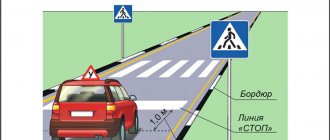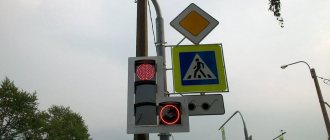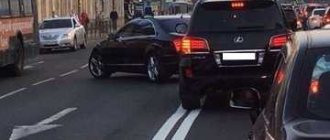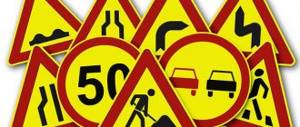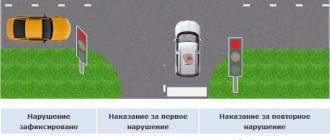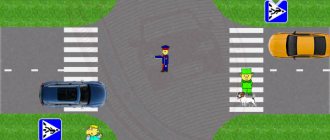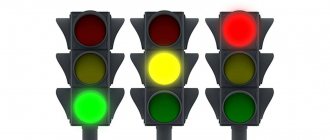Fine and deprivation of rights for violating clause 6.14
Such a seemingly frivolous offense, such as driving through an intermediate traffic light, can entail serious liability in the form of deprivation of the motorist's special right to drive a vehicle.
The fact is that the Code of Administrative Violations does not provide for a separate negative sanction for driving on yellow. The legislation assumes responsibility only for driving through intersections that prohibit the passage of a color, which is yellow from the point of view of traffic rules.
Thus, driving through an intermediate signal entails:
- a material penalty in the amount of one thousand rubles (according to part one of Article 12.12 of the Administrative Code) - for the first case of driving through a yellow traffic light;
- a fine in the amount of 5 thousand rubles or confiscation of a driver’s license for a period of 3 months to six months (according to part three of Article 12.12) - for a repeated violation, that is, driving on a yellow light within a year from the date of the last similar offense;
- a fine in the amount of one thousand rubles or confiscation of a driver’s license for a period of 3 months to six months (according to part one of Article 12.10) - for crossing railway tracks on a yellow traffic light
- a fine of 800 rubles - for late braking and crossing the stop line when stopping in front of an intersection.
All offenses related to the yellow signal can be paid during the grace period. For payment within the first 20 days from the date of receipt of the fine receipt, a discount in the amount of half of the expected sanction is awarded. The only exception is repeated traffic violations.
Administrative liability for violation
Failure to comply with traffic rules not only causes negative consequences (accidents, car breakdowns, etc.), but can also lead to penalties.
Moving to a yellow light entails administrative liability in the form of 1,000 rubles. fine In case of repeated violation, the driver will be required to pay 5,000 rubles.
The fine can be paid much less if you pay the receipt within 20 days. Then the amount of the penalty will be half as much. In some cases, they may be deprived of their rights for up to 4-6 months.
It is almost impossible to prove that the driver could have slowed down without using emergency braking at a yellow light. To achieve this, it is necessary to carry out a forensic technical examination, but in this case it is not done.
The inspector can independently assess the entire situation, and also analyze whether an emergency situation could arise.
Camera fine
Automated equipment is installed in high-risk areas or in areas where drivers frequently commit traffic violations. Such a section of the roadway can be, for example, an intersection. Cameras record driving through a stop sign, as well as hitting a stop line.
However, the recording of such violations according to GOST standards cannot entail holding the motorist accountable. This means that the driver will not receive a fine for driving through an intermediate traffic light signal recorded by the camera.
What do the traffic rules say?
If there is a sign on the road, then the driver is obliged to stop, regardless of whether a stripe is applied or not on the asphalt surface.
If the driver does not stop in front of this line, the driver is charged with violating traffic rules and is issued a fine in accordance with the approved Decree of the Government of the Russian Federation No. 1090 of October 23, 1993. The punishment is imposed on the basis of Article 12.12 of the Code of Administrative Offenses of the Russian Federation.
Markings and signs in traffic rules have equivalent effect.
Today, offenses under Article 12.12 are recorded not only by traffic police inspectors, but also by surveillance cameras, which are equipped at most intersections on main city and intercity highways.
Based on the results of video surveillance, letters are sent to fines indicating the amount of the fine and the deadline for its payment.
Article 12.12 of the Code of Administrative Offenses of the Russian Federation states on what basis the amount of the imposed administrative penalty will be based.
The amount of fines directly depends on the type of road intersection:
- at an intersection that is regulated by traffic lights and has a stop sign or markings - 800 rubles;
- at the intersection of 2 roads, which is not regulated by traffic lights, but with an existing line on the asphalt surface and a stop sign - 500 rubles.
Official interpretation for 2021
It is interesting that clause 6.14 has never been changed during the entire period of its existence. This provision has exactly the same wording as in 1993, when it was adopted. The essence of the point is as follows:
If a motorist, when the traffic light turns on yellow or the traffic controller gives the “Stop” signal (raised up baton), cannot stop without resorting to sharp braking, he must drive on without stopping. Pedestrians crossing the roadway in this situation must immediately move to the sidewalk. In the event that the inverter cannot be abandoned, pedestrian traffic participants take a safe place on the line dividing oncoming traffic.
What the Rules say in 2021
If the traffic light turns yellow and the driver cannot quickly stop in those places specified in clause 6.13 of the traffic rules, then he can continue driving. What should pedestrians do in this case if they are in the middle of the road at the time? They must quickly leave the roadway, and if there is not enough time, then they need to stand on the dividing line that divides the flows of different directions. This point has never changed at all, from 1993 to the present.
Comments to paragraph 6.14 of the traffic rules
The rather ambiguous wording of the clause gives rise to various kinds of controversial situations in which the party more knowledgeable with legal subtleties wins. Thus, the owner of the vehicle can refer to the fact that he managed to drive through the yellow light and at the same time could not brake without creating an emergency situation.
The traffic police inspector will insist that the intermediate signal is still prohibitive. On this basis, the road service officer will insist on bringing the motorist to administrative responsibility.
Comments to the Rules clause 6.14
This point seems simple to understand, but causes many controversial situations. Drivers are inclined towards personal innocence, as they believe that they managed to jump the yellow light. But the traffic police inspector insists on charges, believing that the yellow signal prohibits movement, and the driver violated traffic rules.
Yellow signal - no driving
All drivers need to remember this rule. Clause 6.2 establishes that a yellow light prohibits the movement of any vehicle, as well as pedestrians. But, nevertheless, an exceptional situation is given in paragraph 6.14. It says that the driver has the right and can move through an intersection or other place that is regulated by a traffic light if there is no way to stop, except for emergency braking.
We are talking about only two situations:
- The yellow light turned on immediately after the green light.
- The yellow light came on along with the red light before the green light. In such a situation, you cannot drive until the light turns green.
What is meant by the term “emergency braking”?
The controversial case usually arises because there is no clear definition of "emergency braking" . There is no such interpretation in the text of the Rules as of 2021. Therefore, car owners and State Traffic Inspectorate employees cannot substantiate their evidence.
Can the following situations be considered emergency braking:
- slowing down with skidding, or when the ABS system is activated;
- normal sudden stop, but without skidding or sliding along the road;
- Is the “emergency” of braking taken into account if another car is moving behind at a short distance?
It will not be possible to find answers to these questions from the text of the Rules, at least in 2021. But in solving practical problems you can find a foothold, and the last point is considered the most correct.
According to clause 1.5, drivers must act in such a way as to ensure safety on the road. This means that if stopping could cause an accident, then you can drive through a yellow light.
This is a generalized conclusion, and each situation is examined by traffic police inspectors separately on an individual basis.
What arguments can be made
This controversial clause of the traffic rules gives a reason to buy a DVR and install it on the car. There are types of such devices that can film the situation behind the car. Often, violation of this clause is determined approximately by State Traffic Inspectorate employees. In this case, special restraint devices are not needed, compared to alcohol intoxication or speeding.
Administrative law implies a presumption of innocence. But it only works theoretically. In reality, judges adhere to the principle that “there is no reason not to trust the policeman,” since he took an oath and cannot deceive. This is the practice of using laws in 2021.
Yellow – prohibiting!
Road users cannot be guided solely by paragraph 6.14 when considering the legality of driving on a yellow signal. It is also important to take into account provision 6.2, which contains information that the yellow signal is prohibitive and prevents the legal movement of vehicles and crossings.
It is necessary to remember about the peculiarities of the wording of clause 6.14 (about the right of the IF to cross the intermediate signal). The provision is worded using the word “may” rather than “shall” in the context of the ability of a road user to proceed at an intermediate signal.
This assumes that the driver is only allowed to act in this way if necessary, so as not to create an emergency situation by braking sharply. However, the regulation does not call for always driving through yellow lights.
Driving on yellow can be done in two cases:
- the green signal expired and the traffic light switched to yellow (some traffic lights of older models are not equipped with a timer and a green flashing function, so the intermediate signal may turn on spontaneously);
- the intermediate signal is turned on together with red when switching to green mode.
In the latter case, traffic rules prevent the passage or crossing of the roadway until the signal allowing movement is turned on.
Traffic lights according to traffic regulations
Traffic rules in paragraph 6.2. They describe in great detail the meanings of traffic lights, knowing and following which you can safely move along the roadway.
- green light allows movement;
- yellow is a prohibitory signal, but exceptions are made in clause 6.14 of the traffic rules;
- flashing yellow warns you to be careful at an uncontrolled intersection;
- red light – movement is prohibited.
It would seem that these simple rules are very easy to follow. However, paragraph 6.14 states that drivers approaching a traffic light on a green light and passing on a yellow light are not required to stop, since this will require emergency braking in front of the stop line. Such actions can create an emergency situation.
In other words, driving through a yellow traffic light is acceptable, provided that you do not have the opportunity to stop the car before the intersection without braking, you have every right to complete the maneuver. Here it is very important to correctly assess the road situation.
What does each signal mean?
In Russia, many drivers move abruptly when the signal is green, and most accidents at intersections occur precisely when a person drives through a yellow light, and finds himself at the intersection of two roads when the light turns red.
The responsibilities of drivers moving on a green light also include the need to give way to those road users who are still completing the maneuver.
What maneuvers should not be done at an intersection to prevent an emergency:
- start driving without waiting for the green light (go to the yellow signal that lights up immediately after the red one);
- try to jump to yellow, which lights up after green;
- drive away abruptly when the light is green, without making sure that other road users have completed their passage.
The term "emergency braking" from a legal point of view
The meaning of the term "Emergency braking" is not specified in the current traffic rules, which opens up room for debate between supporters of different views.
In particular, controversial opinions raise the following questions:
- whether the braking is “skid” or emergency braking before ABS is activated;
- does increased pressure on the brake pedal without skidding fit the specified definition?
- Is it possible to consider driving on yellow as an option if the vehicle moving behind does not comply with the safety distance standards?
In the traffic rules, subjects of legal proceedings will not find answers to the questions posed, which means each party is obliged to defend their point of view with the help of evidence. It is important to note, however, that the third of the considered options has the most successful justification for travel.
In the process of making a decision regarding passage to an intermediate traffic light, motorists must be guided by paragraph 1.5 of the traffic rules. According to this provision, road users are obliged to avoid creating danger on the road by all available means. In the context of the situation under discussion, a motorist must stop at a yellow signal or proceed in order to prevent an accident.
In court, each such proceeding is considered individually. A motorist cannot unreasonably claim that he was preventing a danger by his action. If, with such a statement, it turns out that the drive was empty and the stop would not have led to serious consequences, the driver will lose the confidence of the court and will face administrative sanctions.
Proof
The motorist can use the data from the DVR (if such equipment is available) as evidence. Moreover, it will be an incomparable advantage if the shooting is carried out not only from the front of the vehicle, but also from behind.
The presence of video materials will allow the motorist to compete with the inspector during legal proceedings. The fact is that the decision for driving on yellow cannot be supported by recording with special equipment. This means that the fine is issued based on the subjective opinion of the traffic police representative.
If the owner of the vehicle does not have any evidence of his innocence other than his own arguments, the case will not be completed in his favor. This is explained by the fact that the court is always inclined to trust the traffic police officers due to the fact that they took the oath. According to the judge, the inspector cannot give false testimony (unlike the driver, who protects personal interests).
What does blinking mean?
A traffic light is intended not only to provide signals prohibiting and permitting traffic. According to the second subparagraph of the sixth paragraph of the traffic rules, the flashing intermediate signal has its own meaning.
An intermittent yellow signal warns traffic participants about an unregulated section of the roadway, and also informs about entering a high-risk zone. If an intermediate signal is detected flashing, motorists and pedestrians should increase their alertness.
Attracting attention like this does not mean stopping immediately. Road users should only reduce the speed limit and prepare to cross a high-risk area.
Is it possible to drive if the green light is flashing and when there is a fine for this?
The answer is quite obvious - you can (for more details, see the article “Fine for flashing green?”). However, it is necessary to act in accordance with the characteristics of each specific situation. Drivers must be guided by paragraph 6.2 of the traffic rules, which prevents legal passage to an intermediate signal. If you need to justify the legality of an action, you need to refer to paragraph 6.14.
Thus, if the driver proves that he prevented the creation of a dangerous situation on the road, he will avoid liability. As an example, we can consider the situation of the obvious need to drive on yellow. Thus, stopping will provoke a collision if the motorist does not assess the road situation and does not notice a vehicle moving behind at high speeds. This way, a flashing signal will not be a reason to stop.
If the motorist is at a decent distance from the regulated section of the roadway and sees the green signal flashing, he must resort to a gradual reduction in speed. By this action, he will promptly make clear to other drivers his intention not to continue driving at the yellow signal. Other road users will be ready to stop and the traffic situation will not become dangerous.
All situations presented will not be accompanied by holding the motorist accountable in the form of financial penalties or deprivation of rights. The actions considered were consistent with the road situation and maintained traffic safety.
It is worth noting that most modern traffic lights are equipped with an expiration indicator. Calculating the remaining seconds allows drivers to make a more accurate assessment of their capabilities. You cannot ignore the timer readings and overestimate your capabilities, hoping to “make it.”
When is it legal to drive through a yellow traffic light?
And let's start with the fact that yellow light, according to traffic rules, is actually prohibitive. That is, if it lights up, you cannot continue driving through an intersection, pedestrian crossing or other sections of the road in front of which a traffic light object is installed.
Formally, such a signal performs 2 functions:
- yellow light prohibits traffic according to traffic rules,
- it also warns that the signal is about to change to red.
This state of affairs is dictated to us by paragraph 6.2 of the Traffic Rules. At the same time, according to the official interpretation, an exception is immediately contained in the form of a reference to another paragraph - 6.14, which prescribes the possibility of driving on yellow if the driver does not have the opportunity to stop in accordance with the requirements of the traffic rules without using emergency braking.
And the requirements of the Rules for stopping at a prohibitory traffic light signal are already contained in paragraph 6.13. According to him, you must stop:
- in front of the stop line, if available,
- if it is absent, then at the intersection in front of the roadway being crossed, but without interfering with the movement of pedestrians,
- on other sections of roads - in front of the traffic light itself.
Thus, if you had the opportunity to completely stop at a yellow traffic light, but you nevertheless drove further, and in this area there is a camera for auto-recording violations, then the fine will be quite legal. But not always... Or, to be more precise, never.
Why? You will find out a little below.
If it's a flashing green light?
No, the photo recording camera cannot record the passage of a flashing green light, because it does not prohibit further movement at all and is only of an informational nature. Even if you barely had time to pass the blinking light, there will be no violation in any case. Accordingly, a fine from a camera for this will be illegal.
This is exactly how it works in practice. There have never been any cases of drivers receiving “letters of happiness” for driving on a flashing green light. Unless by mistake.
If we are talking about driving on a flashing yellow light?
Will cameras be fined for flashing yellow traffic lights in 2021? Quite yes. But, again, we are talking about erroneous fixation.
The fact is that such a signal in itself also does not prohibit further passage. Moreover, it generally makes the intersection unregulated and becomes such when, for example, the traffic light is faulty or a traffic mode is organized on a given section of the road when the traffic light object is automatically switched to blinking mode at a certain time (for example, at night). Most often this happens at pedestrian crossings.
And if the traffic light breaks down, resulting in the yellow blinking light, then the camera hanging above it can continue to record traffic violations. Although, this is rare, because most often the auto-fixing means are synchronized with the operating mode of the traffic light, and if the latter breaks down, they also stop removing it.
You will also be interested in:
- Fine for non-working rear license plate light in questions and answers
- Is there a penalty for driving with a broken, broken or cracked windshield and what is it?
- What is the fine for a “Brick” sign at a gas station, how to avoid it and cancel it?
How can I appeal this violation?
Drivers, when stopped by a traffic police officer for driving through a prohibitive intermediate traffic light, must attempt to settle the matter on the spot. This option is quite accessible due to the ambiguity of the wording in the legislation. It is worth trying to explain your actions and indicate the possibility of providing evidence (if any).
If the inspector remains adamant, but the motorist completely disagrees with the alleged offense, the latter should not sign the protocol. If the document is signed, it will be much more difficult to prove innocence.
The owner of the vehicle can count on the successful completion of the case if there are the following justifications:
- Video materials from the recorder. It is worth noting that in such situations, having a DVR is almost necessary. A motorist's investment in the purchase of this device will undoubtedly pay off if the driver finds himself in such a controversial situation.
- Eyewitness testimony . The driver must make sure that witnesses can be found after the incident: you need to take their contact information.
- Link to Article 2.7 of the Administrative Code of the Russian Federation. This provision stipulates that a person cannot be prosecuted for an unlawful act that allowed him to avoid more serious consequences.
It is important to know: an administrative case is considered open from the moment the protocol is signed. To indicate non-acceptance of the traffic police officer’s opinion regarding his guilt, the motorist cannot limit himself to the mark “I do not agree with the alleged violation” in the protocol.
The main thing is not to sign the document and the notification of its receipt on the spot. In this case, traffic officials will be required to send the order to the home address of the alleged violator.
It must be remembered that in the Russian Federation the basics of the presumption of innocence in the auto sector are ignored. For this reason, inspectors have the right not to justify their decision to hold the driver accountable. Representatives of the judicial authorities will take the employee’s word for it, and the driver will be required to provide evidence of innocence.
As a conclusion, it is worth noting: if you have the opportunity to stop before a prohibitory traffic light, you need to slow down. Prudence and caution while driving will help the motorist avoid serious consequences. We are talking not only about holding authorities accountable, but also about the general safety of road users.


